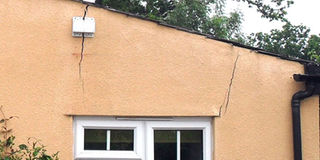Prime
Repair a damaged house foundation

Construction delays and extended periods where the house is left unfinished ultimately affects the quality of the end product.
A small crack on the wall can easily become a more serious problem if left unattended. That is why it is important to fix a damaged foundation, writes Christine Katende
For a house to last longer, it needs to have a strong and firm foundation that can hold and support the upper part of the house from collapsing.
Most construction engineers say that the biggest percentage of the buildings that collapse in the city centre occur due to weak foundations that are in most cases constructed with poor materials.
Mr Richard Sonko, a resident of Buziga, built his three bed-roomed house in a swampy-like area. After four years of occupancy, sand started getting off from the foundation.
Mr Sonko adds that it was when he saw the wall of his room getting washed away that he later contacted a house contractor who helped him with knowledge on how to repair the foundation without demolishing the whole house as he had earlier planned.
Just like Mr Sonko, many people have damaged house foundations, but they have no idea on how to fix them. Some people have already lost their houses, lives and property.
Rev Vincent Musoke, a civil engineer, says that most damaged foundations are settlements that are caused by imbalanced load (forces) that are always weak.
“The forces from the walls that are built on it, force it down easily thus developing cracks in the walls and leading to sinking of the foundation,” he explains.
Methods used
He adds that most of damaged house foundations are repaired using a method known as pinning method system. The system involves a variety of supporting equipments like iron bars and timber that are supported in two ways which include dead shoring and flying shoring.
Mr Musoke says that with dead shoring, timber is passed through the walls at intervals. It is done to support the weight of the walls as the foundation is repaired using proper mixture of concrete and bricks.
He advises the person doing the repairing process to start with the weakest part where damage seems to be strong. “Cut out or remove the damaged part, start replacing it with new concrete and it has to be done in intervals to avoid the walls from collapsing.
Mr Ambrose Nsenge, a builder with Kasense Real Builders Company, says before going on with the repairing process, one has to remove the damaged or old plaster, lay a block slate that is mixed with lake and liver sand, cement and water. Replace it with the new plaster and later with water proof if the house is constructed in a swampy area.
Also, apply a rough cast to make it farm, then apply a copping layer and furnish it with paint of one’s choice to make the house look new.
Mr Nsenge attributes that most of the house foundations that get damaged are caused by water that sinks the bricks and sand used while setting up the foundation. He advises that for one to have a good and long lasting house foundation, he has to lay polythene immediately after the foundation trench is dug.
Also, lay the bricks up to the end of the foundation and cover them with the other part of the polythene. This is done to make the foundation firm and prevent it from getting filled with water.
Repair process
Mr Musoke says that all damaged house foundations are repaired by following steps below.
lMark points of damage and carry out the assessment which involves the cost of the materials to be used so as to make the repairing work easy.
Construct the shoring.
Excavate the damaged points of the foundation. This is done at different intervals to avoid extra damage.
Pour concrete and lay the bricks.
Give allowance of 14 days for the concrete to dry and become strong before tackling the other part.
Remove the shorings after work is complete, but ensure that all damaged spots are covered and given enough time to dry.
Remove all the waste material to leave the place clean.




